( ESNUG 539 Item 2 ) -------------------------------------------- [05/08/14]
Subject: The nitty-gritty details to that design and IP survey Infographic
> In an engineering group, enormous energy and processes can often go into
> making "design reuse" happen, yet "verification reuse" is often neglected.
> For efficient IP reuse across the enterprise, your company must master
> BOTH the design AND the verification aspects.
>
> - Dean Drako, IC Manage
> http://www.deepchip.com/items/0520-01.html
From: [ Dean Drako of IC Manage ]
Hi John,
We just finished our 6th annual survey on global design and IP management.
This year 361 design and verification professionals responded, including a
mix of managers, analog and digital designers and verification engineers.
The main thrust of last year's 2013 report finding was that:
IP reuse 2.0 == design reuse + verification reuse
If I had to characterize this year's 2014 main report finding, it is that
design and IP management has gone well beyond only one system at one site.
In fact 82% of companies now have multiple design sites, and more than half
of companies have at least 2 different DM systems.
This complexity and duplication result in increasing interdependencies
between teams. For the entire system to work, companies will need to:
Have a global design view, while making
local AND remote sites EQUALLY efficient
The winning hardware design teams will use a combination of management
policies/processes -- plus DM tools that have a global system view and
IP reuse -- plus an adequate supporting infrastructure for every site;
plus mechanisms to manage the all of the interdependencies.
The goal is for:
- each design engineer
- each verification engineer
- plus each project lead
at EACH site to go through their workday with high performance, non-
conflicting access to their project's up-to-date design data.
---- ---- ---- ---- ---- ---- ----
COMPANY POLICIES ON INTERNAL IP REUSE MODIFICATION
Only 13% of organizations have a "do not touch" IP reuse policy, while 87%
allow some modifications. Also interesting is that only 19% of companies
allow designers to freely modify all the internal IP.
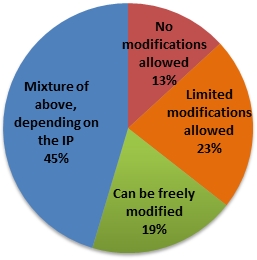 An aside to this is we've found quite often a company's internal IP doesn't
work. That is, it works functionally, but it's unusable when they try to
reuse it elsewhere for physical reasons -- like crosstalk issues or it not
being able to drive a system bus.
---- ---- ---- ---- ---- ---- ----
WHO/WHAT DRIVES INTERNAL IP REUSE
In our earlier 2013 survey, we found that 62% of companies had some flavor
of engineering incentives for design reuse, and 56% had incentives for
verification reuse.
An aside to this is we've found quite often a company's internal IP doesn't
work. That is, it works functionally, but it's unusable when they try to
reuse it elsewhere for physical reasons -- like crosstalk issues or it not
being able to drive a system bus.
---- ---- ---- ---- ---- ---- ----
WHO/WHAT DRIVES INTERNAL IP REUSE
In our earlier 2013 survey, we found that 62% of companies had some flavor
of engineering incentives for design reuse, and 56% had incentives for
verification reuse.
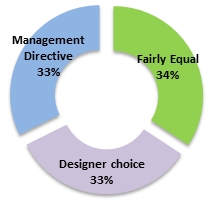 Perhaps that is what led to 2014's very balanced breakdown of how companies
are driving internal reuse, with one-third each where it is being driven 1)
by top down directives, 2) by designer choice or 3) by a balance of the two.
For the record, we're starting to see some companies that are giving
internal recognition to engineers who make & support reusable IP -- or
who make someone else's IP reusable. It's working for them.
---- ---- ---- ---- ---- ---- ----
MULTIPLE DESIGN & IP MANAGEMENT SYSTEMS USED
We've found that more than half of companies (55%) have more than one design
management system. The worst case situation we've seen had 7 different
types of DM SW with 222 IP repositories across 15 global sites.
Perhaps that is what led to 2014's very balanced breakdown of how companies
are driving internal reuse, with one-third each where it is being driven 1)
by top down directives, 2) by designer choice or 3) by a balance of the two.
For the record, we're starting to see some companies that are giving
internal recognition to engineers who make & support reusable IP -- or
who make someone else's IP reusable. It's working for them.
---- ---- ---- ---- ---- ---- ----
MULTIPLE DESIGN & IP MANAGEMENT SYSTEMS USED
We've found that more than half of companies (55%) have more than one design
management system. The worst case situation we've seen had 7 different
types of DM SW with 222 IP repositories across 15 global sites.
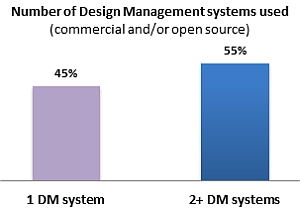 Sometimes it can be the difference between the analog and the digital teams
in a company. Sometimes in large company subdivisions run independently
for historical reasons -- driven by major acquisitions. However if only a
small team is acquired, it is generally expected to move the new incoming
engineers onto the majority's DM system.
Sometimes it can be the difference between the analog and the digital teams
in a company. Sometimes in large company subdivisions run independently
for historical reasons -- driven by major acquisitions. However if only a
small team is acquired, it is generally expected to move the new incoming
engineers onto the majority's DM system.
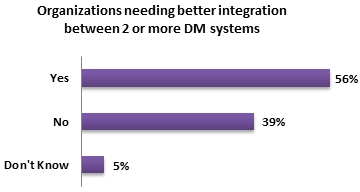 Slightly more than half (56%) of companies with more than one DM system need
better integration.
Slightly more than half (56%) of companies with more than one DM system need
better integration.
 The problem is that engineering groups are under such pressure to meet a key
tape-out schedule, they can't afford to take the time off to migrate to one
unified DM system. Then they have chronic handoff issues that temporarily
get fixed with a lot of hand-scripting, lots of repeat emails, and follow-on
spreadsheets. Then the engineering group starts its next tape-out late due
to all the prior tweaks they had to do; and the process repeats.
To make matters worse, each project loses its DM back-traceability, too.
It's a vicious cycle that they can't seem to break.
---- ---- ---- ---- ---- ---- ----
SECURITY ISSUES WITH FILE-BASED ACCESS CONTROL SYSTEMS
Mimicking recent Internet problems with the Heartbleed OpenSSL bug, almost
70% of chip companies have cited some form of security issue with their
present file-based access control system.
The problem is that engineering groups are under such pressure to meet a key
tape-out schedule, they can't afford to take the time off to migrate to one
unified DM system. Then they have chronic handoff issues that temporarily
get fixed with a lot of hand-scripting, lots of repeat emails, and follow-on
spreadsheets. Then the engineering group starts its next tape-out late due
to all the prior tweaks they had to do; and the process repeats.
To make matters worse, each project loses its DM back-traceability, too.
It's a vicious cycle that they can't seem to break.
---- ---- ---- ---- ---- ---- ----
SECURITY ISSUES WITH FILE-BASED ACCESS CONTROL SYSTEMS
Mimicking recent Internet problems with the Heartbleed OpenSSL bug, almost
70% of chip companies have cited some form of security issue with their
present file-based access control system.
 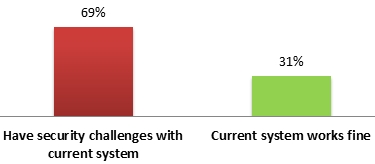 Although not as severe as Heartbleed, the DM problems ranged from managing
security across multiple operating systems (Windows, Linux, Mac...), to
dealing with remote sites, to audits, to government compliance, and/or the
granularity with which security could be assigned.
Although not as severe as Heartbleed, the DM problems ranged from managing
security across multiple operating systems (Windows, Linux, Mac...), to
dealing with remote sites, to audits, to government compliance, and/or the
granularity with which security could be assigned.
 And another related IP security issue is IP theft is rampant all over the
chip design world. Although the U.S. Media likes to show that this is
something happening mostly in China -- the scary truth is it's happening all
over the world, in the rest of Asia, in the U.S., in Europe, everywhere.
---- ---- ---- ---- ---- ---- ----
MULTI-SITE DESIGN AND IP MANAGEMENT
Roughly four out of five companies develop and verify designs across more
than one site.
And another related IP security issue is IP theft is rampant all over the
chip design world. Although the U.S. Media likes to show that this is
something happening mostly in China -- the scary truth is it's happening all
over the world, in the rest of Asia, in the U.S., in Europe, everywhere.
---- ---- ---- ---- ---- ---- ----
MULTI-SITE DESIGN AND IP MANAGEMENT
Roughly four out of five companies develop and verify designs across more
than one site.
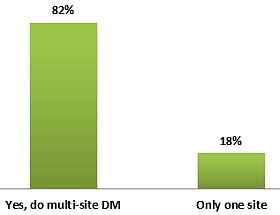 Next, in part 3 of this post, I will go into the subtleties of multi-site DM
requirements -- as ranked according to the user priority order -- whether
you are using an open source or commercial DM system.
Topics span: global design visibility; visibility into all available IP;
remote site performance; bug interdependency management; designer handoffs
with audit trails; and resiliency to remote network disruption.
- Dean Drako
IC Manage Campbell, CA
---- ---- ---- ---- ---- ---- ----
Related Articles
SCOOP! - Dean Drako's design and IP management survey Infographic
Nitty-gritty details to that design and IP survey Infographic
What design and verification engineers want on global projects
15 gotchas found in Design and IP data management tools (part I)
15 gotchas found in Design and IP data management tools (part II)
Dean Drako on IC Manage, Subversion, DesignSync, ClioSoft, CVS
Next, in part 3 of this post, I will go into the subtleties of multi-site DM
requirements -- as ranked according to the user priority order -- whether
you are using an open source or commercial DM system.
Topics span: global design visibility; visibility into all available IP;
remote site performance; bug interdependency management; designer handoffs
with audit trails; and resiliency to remote network disruption.
- Dean Drako
IC Manage Campbell, CA
---- ---- ---- ---- ---- ---- ----
Related Articles
SCOOP! - Dean Drako's design and IP management survey Infographic
Nitty-gritty details to that design and IP survey Infographic
What design and verification engineers want on global projects
15 gotchas found in Design and IP data management tools (part I)
15 gotchas found in Design and IP data management tools (part II)
Dean Drako on IC Manage, Subversion, DesignSync, ClioSoft, CVS
Join
Index
Next->Item
|
|



